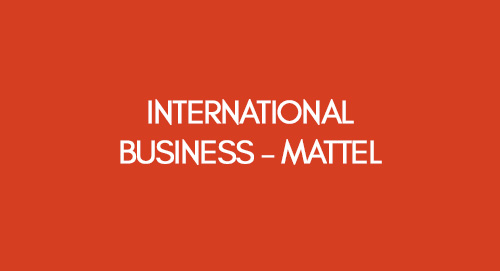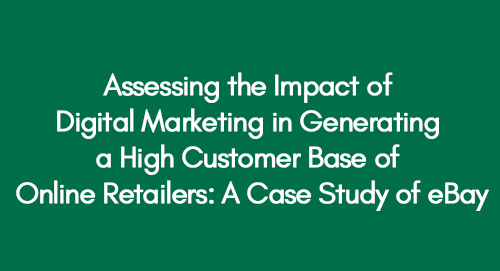
Business Strategies: Tesla Inc
January 15, 2021
Gaining Sustainability in the Construction Industry: Integration of Life Cycle Assessment (LCA) into Building Information Modeling (BIM)
January 15, 2021Introduction
Headquartered in California, Mattel, Inc, was founded in 1945 and is currently a leader in the designing, manufacturing and marketing of toys and family products. The company has its sales distribution in more than 150 with its top line to earn nearly $6 billion annually.
Need Help with Academic Writing? Get a Response within 24 Hours!
The company has four major product categories: - Fisher-Price (including Fisher-Price, Thomas & Friends and Little People), Mattel Boys & Girls (including Hot Wheels, Monster High and the most popular and fashionable doll produced, Barbie), Construction and Arts & Crafts (including Board Dudes, RoseArt & Mega Bloks) and American Girl (including BeForever, Bitty baby & Truly Me). In addition to this, there is a wide range of entertainment-led toy lines amongst which several are tied with motion pictures and television shows (Mattel Inc. 2016).
The US Market
Strategic Importance Of USA Toy Industry For Mattel
The US is typically receiving a great deal of attention from toy companies that want to expand operations outside their home markets. With the overall improvement in the US economic conditions in the year 2011, the games and toy industry experienced significant growth.
Demand for games and toys increased because of consumer willingness to spend more on toys. Electronic games were the leader in this segment of the industry after which dolls, stuffed toys and collectables ruled the market. Even board games hold a substantial share in the market. Mattel Inc to enter the US toy market requires few wins so as to make the sales ramp up high (Carroll, 2004). Three key factors which Mattel should consider in expanding its operations in the US market include:
Selling Toys in the Massive US Market Requires Greater Numbers
This appears to be a great opportunity, except that a huge amount of cash is required to cashflow a business that is operating on this scale. This can be explained in this way – if the company makes a deal of making its 3 products listed with the largest retailer in supposing the Netherlands, the company will do well for selling 30,000 units over those three products.
However, if the company wants those 3 products to be listed with Target or Wal-Mart in the US, the requirement will be more like 300,000 to 500,000 units over those 3 items on the average performance of products. Now presuming, that the cost of manufacturing is about $3 per unit, the company will be looking for a $million cash flow to only get the stock manufactured. This clearly comes out as a massive opportunity that also comes with big challenges at the same time which can be underselling of the stock or cancellation of orders by the retailer which can lead to the challenge of stock management (Securities and Exchange Commission, 2016).
Another way to sell can be through FOB only e.g., the retailer will take the stock at ports of Vietnam, India, China, etc. and then it will be their responsibility. This can be appealing but retailers buy FOB only when it suits them and not the company. This means that there is simply no guarantee that the terms will be helpful in reducing the risk factor.
Bottom line is that the US toy market can be quite unpredictable for fewer must list toys because an excellent year of 5 – 6 listings can be followed by a bad year with hardly 2 listings or even the delisting of products. This can be very challenging in terms of overhead obligations (Securities and Exchange Commission, 2016).
a) Sales Reps Culture
An important aspect of the US toy market that can be strategically important for Mattel is to sell to retailers through reps. This is very usual in the US as there are several established sales rep teams that are turning over millions of dollars. Mattel will have to sell to retailers in the industry through reps. The tradition of reps is a feature of US geography as it is a vast country. Hiring the services of a good rep can be a way to access retail accounts along with being able to maintain and grow listings once the account starts running (Mattel Inc. 2016)
b) Logistics Is Important
Another key factor that Mattel needs to consider is distribution and logistics. The US have sprawling geography where opportunity is great and so is the challenge of delivering products all over the country. For example, Wal-Mart only has more than 40 regional distribution centres. Many businesses fail only because they fail to handle the supply effectively and profitably as well (Mattel Inc. 2016).
Political Factor Affecting Mattel
Several political factors impact Mattel in the US however, political developments such as trade relations or threat or occurrence of terrorist activities can adversely affect operations of the company, its facilities and personnel, its suppliers and customers, financial and retail markets as well as its overall economic conditions (Securities and Exchange Commission, 2016).
Mattel’s business is present worldwide serving more than 40 countries. Civil unrest, political instability and the deterioration of political conditions in the US can result in the breakdown of trading relations between the US and the foreign country in which Mattel has its manufacturing facility and operations. This can adversely impact Mattel’s financial condition and business operations.
Recent changes in the trade status of the US with China can result in a significant rise in the import duty of toys that are manufactured in China and imported in the US. Trade restrictions, increasing cost of labour, unfriendly national laws and labour unrest in China can have an adverse effect on Mattel. Prolonged and tense trade relations between the US and China along with the control of the Chinese government over foreign business operations and investments appears to be a great risk for Mattel in the US (Securities and Exchange Commission, 2016).
The imposition of tariffs on several Chinese imports which will result in taxes over imported goods can make things worse for businesses. This will also have a huge impact on the global supply chain which is the key part of world trade.
In order to deal with this political issue, Mattel should recognize the recent trends towards centralization. China tends to maintain its focus upon longer-term priorities. This can involve policies that will have little or nothing to do with the US and which is believed to improve competitiveness.
Additionally, China has cutoff tariffs on more than 1,500 products and has also eased up some of its investment restrictions which can be an indication of improved US-China trade relations. By technologically-innovating products, Mattel can have a gateway to be less affected by the increasing tension between US and China as China is opening up for sectors that are ranging between financial services and technology (Lev-Ram Michael, 2017).
Innovation and Corporate Social Responsibility (CSR)
Factors Influencing Innovation At Mattel
New Product Introduction (NPI) Trends within the Toy Industry
In order to extend the product lifecycle in the market, innovations are now considered to be extremely important so as to maintain the market share. It has become very essential to bring in significant changes within processes and products in accordance with innovative design and relative technology (Stephanie Wissink, 2017).
New tools and methods are being implemented to reduce the timeline of new product introduction. 3D modelling and simulation software like 3DCAD is developing rapidly. When the simulation process is applied within the designing phase it can offer additional opportunities to Mattel to speed up over-designing details. Moreover, any issues can also be identified more visibly. This prototype technology will enable designing and developmental plans to be evaluated at an early stage.
The Wi-Fi, voice-activated Dreamhouse of Barbie is a great example and enabled kids to open up doors using spoken commands. All was good until the CEO realized that there is too much circuitry and chipboards are separate and that Mattel was not using them to their full potential. Additionally, there were no software updates in the Barbie Dreamhouse which would hinder the company to add new features to the toy product (Mattel Inc. 2016).
Technology Driven Age Compression
Listed to be a key trend in the toy industry in Mattel’s 10-k, the phenomenon faced by the company is that of ‘children becoming older younger’. This eventually outgrows toys at a very young age. According to a study conducted at the University of Iowa, half of the toddlers are able o use iPads at the age of 1 and 90% of these toddlers tend to master the gadget until they reach the age of just two years. Spending more time on iPads and Netflix eventually means that less time is being served in playing with Mattel toys and figurines (Goldstein, 2012).
In early 2017, the company hired Margo Georgiadis, former Google Executive to be the new CEO and usher within a digitally-focused business strategy. A part of this strategy included developing interactive games, toys and live content for the core brands of the company. The voice-activated digital teacher and nanny assist children in learning basic skill sets. Aristotle monitors kids, teach them basic cognitive skills and will also help them with their homework. The marriage of Mattel’s analogue past and Georgiadis’ innovative digital future appears to be the recipe of success however, what role the company will play in the next generation play world is yet to be determined.
International Business Challenges faced by Mattel
Global Pricing Strategy and Cost Calculation
The trend of new product introduction in the toy industry and detailing the designs and features can pose challenges when conducting business internationally and should be an important factor in the development of a business strategy. Mattel faces the challenge of closely considering costs so as to remain competitive in the industry and deal with the changing trends as well so that profits are assured.
The company needs to research the pricing strategy of local market competitors which can serve as a benchmark. The cost of production, shipping charges, marketing, distribution and labour along with the profit margin are some factors that Mattel should take into account for making it's business viable globally (Katie Reynolds, 2016).
Foreign Laws and Regulations
To get the structure of the organization in place, it is very important that the local laws and regulations of a foreign country must be understood carefully and be abided by accordingly. From laws governing trade to taxation laws legal requirements has become a central function for making an international business successful. Moreover, employment and labour requirements also differ from one country to another (Katie Reynolds, 2016).
Mattel’s partnership with Chinese toy manufacturers marks a new era in the toy industry. The collaboration released a new A.I product named Aristotle is an excellent combination of research & development and technology. China, being a hub of technology and a strict follower of the Foreign Corrupt Practices Act will never allow any unethical practices within international business. Being aware of the Chinese business environment will help Mattel deal with potential laws and regulations in the country (Romero Isidoro, 2012).
CSR Considerations For Mattel
The Altruistic Strategy
Experts suggest that business organizations are not responsible to society, rather the obligation of being socially responsible falls upon the management of business organizations (Murray and Vogal, 1997). That is, the organization is considered as an artificial person and can bring good or harm to society and the environment. In such a situation, it is important for firms to predispose is social responsibility beyond profit maximization (Joyner and Payne, 2002; Angelidis and Ibrahim, 2004; Hemingway and Maclagan, 2004).
Mattel to develop an interwoven relationship with the community should consider ‘giving something back in the form of philanthropy so as to make a positive contribution to the society and community. This can be typically done by the surplus profits of the company which can be distributed according to the moral and social precepts and social values and surpluses can be channelled to different educational, social, cultural or recreational aspects (Hemingway and Maclagan, 2004). The altruistic strategy appears as an act of goodwill though; Mattel may not measure its direct benefits.
The Citizenship Strategy
This strategy involves a broader scope and incorporates that different stakeholders have different expectations and interests including suppliers, customers, shareholders, employees, the environment, particular communities and so on. The strategy can be best described from the stakeholders’ point of view (Freeman, 1984; Clarkson, 1995; Donaldson and Preston, 1995).
The strategy not only recognizes its responsibilities towards potential external constituents beyond shareholders but, to the internal components as well (Dawkins and Lewis, 2003). The reality is that the demand of stakeholders is mutually exclusive and no firm can necessarily treat its stakeholders in the same manner (Sethi, 2003). In such a situation, Mattel may categorize its stakeholders to be primary and secondary stakeholders (Clarkson, 1995).
To incorporate the CSR strategy, Mattel needs to proactively make dialogues with its stakeholders and integrate their suggestions in the decision-making process. Within this strategy, stakeholders’ needs are essential as both input and output for developing a corporate strategy. Although the potential benefits of citizenship strategy may not materialize within a short time frame, however, this CSR strategy can provide tangible rewards like improved financial results along with intangible rewards like excellent reputation in the market (Margolis and Walsh, 2003).
Mattel Supply Chain Management
Integration
This is perhaps, the heart and brain of Mattel’s supply chain. Integration within the supply chain management means coordinating communication between the different elements of the supply chain for producing and delivering timely and effective results. Integrating refers to the exploration of new software or other technologies so that communications within departments can improve. Mattel has invested in its digital supply chain through the JDA software group which will bring in improvements across the manufacturer’s end-to-end supply chain processes. JDA has joined hands with KPMG to lead the solution design and its deployment (Chiarini, 2014a).
Increasing Mattel’s business demands both products as well as channel innovation which can pave new market routes like e-commerce, penetration of new customer segmentation and growth in emerging international markets. In addition to this, the company is also focused on improving its profitability by optimizing its global supply chain. By developing an integrated supply chain solution the company has the aim to fulfil its customer demand rather effectively while reducing both operating and inventory costs (Keitsch, 2012).
Operations
This link within the supply chain coordinates with operations carried out on a daily basis. Basically, it is to assure that the output is planned well and the advantages are maximized. It also helps in keeping an eye over the inventory and can be used to predict o forecast which supplies will be needed at what time and by whom so as to predict the effectiveness of products, marketing strategy and the end-user results (Rahimifard, et. al., 2013).
Mattel’s engineering staff is well-equipped in designing production process which is capable of being scaled up in periods of high demand without straining any procedure or element. Because of this component, Mattel faces very little difficulty to gear up for the holiday season and the engineering of the final product is tightly integrated within the supply chain.
Weakness in the SCM of Mattel
Distribution is a very important element in the supply chain for any organization and Mattel Inc. is no exception. Logistics amongst wholesalers, retailers and clients is the responsibility of the distribution element of the supply chain command. Mattel is currently distributing to large retailers only such as Target or Wal-Mart and a huge portion of its sales is heavily dependent upon these retailers (Amy Johnson, 2002). In FY 2015, around 48 per cent of net sales of the toy manufacturer were generated from large scale retailers that amounted to 10 retailers only.
This over-dependence upon a few retailers in the industry tends to reduce the bargaining power of the company. Moreover, in case any of the retailers ran out of stock and were not delivered on time, it can impact the margin of both Mattel and the retailer as consumers may switch to another toy brand because of its unavailability. Moreover, they will also be less likely to purchase Mattel products for some time because of their disappointment (Kaipia and Holmström, 2007).
References
- “Code of Conduct.” Mattel. Web. <http://corporate.mattel.com/about-us/ethics.aspx>.
- “Mattel History.” Mattel. Web. <http://corporate.mattel.com/about-us/history/mattel_history.pdf>.
- “
- Amy Johnson, (2002) “A New Supply Chain Forged,” Computerworld, pp. 38–39.
- Chiarini, A. (2014a). Strategies for developing an environmentally sustainable supply chain: Differences between manufacturing and service sectors. Business Strategy and the Environment, 23, 493–504. doi:10.1002/bse.1799
- Collin, J. (2003), “Selecting the right supply chain for a customer in project business – an action research study in the mobile communications infrastructure industry”, Helsinki University of Technology, Espoo
- Davenport, T.H. and Brook, J.D. (2004), “Enterprise systems and the supply chain”, Journal of Enterprise Information Management, Vol. 17 No. 1, pp. 8-19.
- Handfield Robert B., Ragatz Gary L., Petersen Kenneth J. ve Monczka Robert M., (1999), Involving suppliers in new product development, California Management Review 42 (1), pp. 59–82
- Heine Christopher, Hasbro’s Digital Transformation Into a Modern Toymaker and Advertiser” Adweek, June 4 2017, http://www.adweek.com/brand-marketing/inside-hasbros-digital-transformation-into-a-modern-toymaker-and-advertiser/, accessed January 30, 2018
- Holmström, J., Korhonen, H., Laiho, A. and Lakervi, H. (2006), “Managing product introduction across the supply chain: findings from a development project”, Supply Chain Management: An International Journal, Vol. 11 No. 2,pp. 1359-546
- https://www.cbsnews.com/news/bankrupt-toys-r-us-spreads-gloom-in-toyland/, accessed January 31, 2018
- Kaipa, R., Holmström, J. (2007), Selecting the right planning approach for a product, Supply Chain Management: An International Journal, Vol. 12, Issue. 3, pp. 3-13.
- Keitsch, M. (2012). Sustainable design: A brief appraisal of its main concepts. Sustainable Development, 20, 180–188.10.1002/sd.v20.3
- Lev-Ram Michael, (2017) “Can a Tech Makeover Save the Toy Industry?,” Fortune, http://fortune.com/2017/09/22/mattel-ceo-most-powerful-women/ , accessed January 30, 2018
- Mattel, Inc. (2016) 20-F (filed February 23, 2017), via EDGAR, accessed January 2018
- Rahimifard, S., Sheldrick, L., Woolley, E., Colwill, J., & Sachidananda, M. (2013). How to manufacture a sustainable future for 9 billion people in 2050. Re-Engineering Manufacturing for Sustainability, 1–8, doi:10.1007/978-981-4451-48-2_1
- Roloff, Julia, and Michael Aßländer. (2010) “Corporate Autonomy and Buyer-Supplier Relationships: The Case of Unsafe Mattel Toys.” Journal of Business Ethics. Web. <http://download.springer.com/static/pdf/516/art%3A10.1007%2Fs10551-010-0522-1.pdf?auth66=1427676236_fff41298d9f3c71a911adb8b288389aa&ext=.pdf>
- Romero Isidoro, Martinez-Roman Juan A. Self-employment and innovation. Exploring the determinants of innovative behaviour in small businesses. Research Policy 41 (2012) pp.178-189
- Stephanie Wissink, (2017) “Mattel, Inc.: Initiating at Hold; Getting All Dolled Up But It’s Complicated,” Jeffries,
- The University of Iowa, “How Toddlers Use Tablets,” https://now.uiowa.edu/2015/06/how-do-toddlers-use-tablets
- The Verge, “Domestic Movie Theatre Attendance Hit a 25-year Low in 2017,” https://www.theverge.com/2018/1/3/16844662/movie-theater-attendance-2017-low-netflix-streaming, accessed January 31, 2018
Get 3+ Free Dissertation Topics within 24 hours?


























